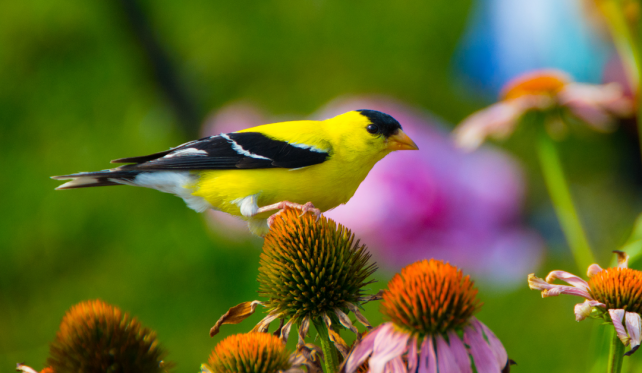Wildlife
A Guide to Planting for Our Feathered Friends

An American Goldfinch on a Purple Coneflower, Echinacea purpurea
JULY 19, 2023
To attract and support native bird populations, it is crucial to provide a safe and thriving habitat. Even if space is limited, setting up birdhouses can offer a cozy sanctuary within your green space. However, the key to success lies in going native. By prioritizing native plants and trees, you can create an environment that meets the unique requirements of native birds and promotes their overall well-being.
Planting for bugs IS planting for birds!
When it comes to planting for birds, most people want to plant a “berry bush”. In many cases, planting a species that produces berries is a fine starting point. However, the first choice should always be to plant something for bugs. According to naturalist & author David Mizejewski, a pair of Chickadees with a brood of 4 chicks will go through roughly 9,000 caterpillars in a 16 to 20-day period. Planting keystone species such as Oaks (Quercus), Willows (Salix) and Cherries and Plums (Prunus) will bring in all the insects birds rely on to feed their young. Oaks alone can support up to 2,300 species of mammals, birds, insects and so much more.
Focus on Diversity
Increase the plant diversity of your micro-habitats as much as possible. When creating spaces for birds, mix it up with shrub borders, flower beds, and areas where you can leave the grass long or where they can scratch in the mulch. Shrub host species such as Spicebush (Lindera benzoin), Wild Gooseberry (Ribes missouriense) and Chokecherry (Prunus virginiana) will provide a diversity of habitat as well as a reliable food source for the birds you attract to your landscape.
Create a Bird Haven with Flowering Forbs!
For ground cover, look to wildflowers! Birds are BIG fans of flower seeds. Instead of buying hanging bird feeders and accessories, real native flowers do the work of seeding, and once established, the upkeep is minimal. Certain birds, like the American Goldfinch, may have specific preferences such as Purple Coneflower (Echinacea purpurea), so it’s important to research to attract desired visitors. Other seed favorites such as Asters (Symphyotrichum) and Goldenrods (Oligoneuron and Solidago) can be a welcome late-season seed source for hungry migrating flocks.
Final Thoughts: Supporting Birds and Biodiversity
Lastly, please don’t spray pesticides or insecticides if you can avoid them. Spraying kills all insects AND the potential for a yard to carry more than a couple of nesting pairs of birds. You can have all the berry producers in the world and it will not be enough to carry one pair of wrens if there are no insects. So be judicious in any application.
It’s important to remember that birds have specific needs and instincts when it comes to choosing a place to gather and build their nests. Providing a safe environment where they can thrive is key. Regardless of what choices you make in planning a space for birds, going native will always be the way to go!